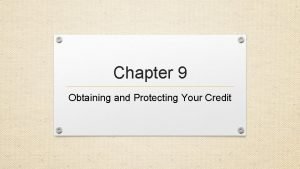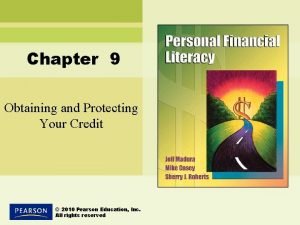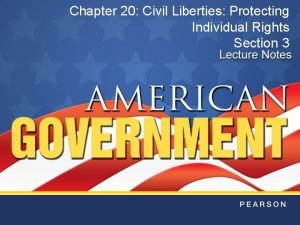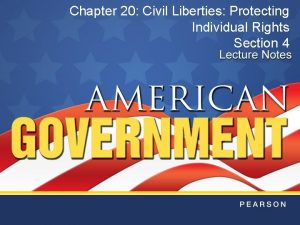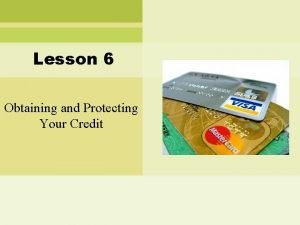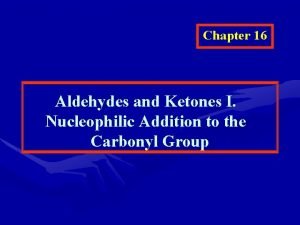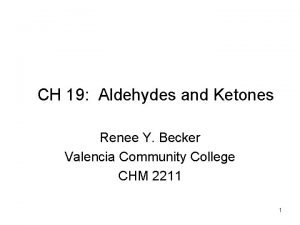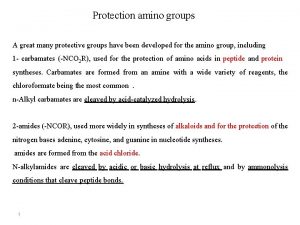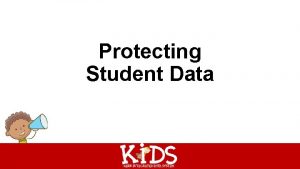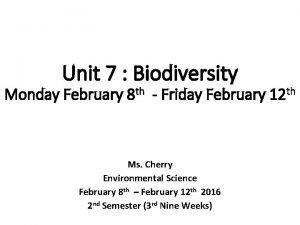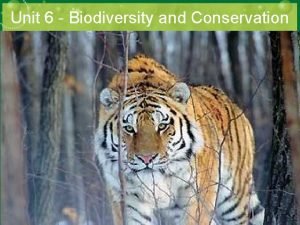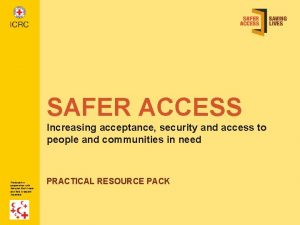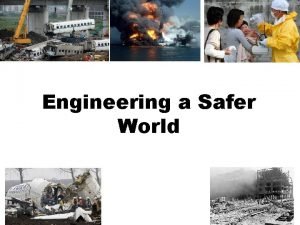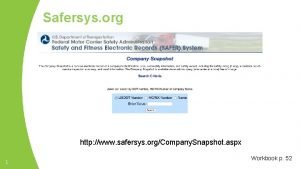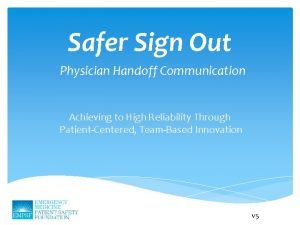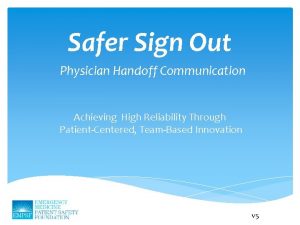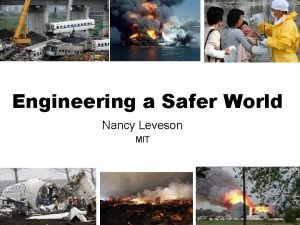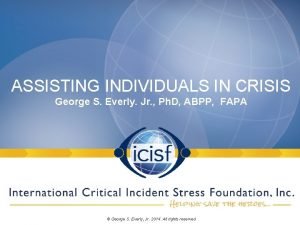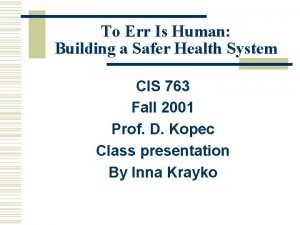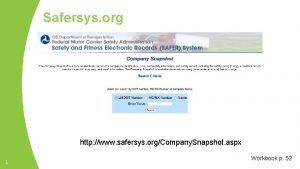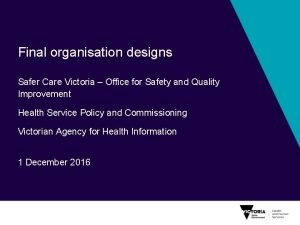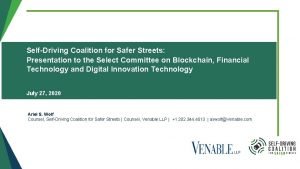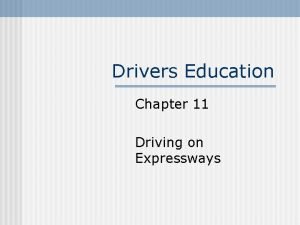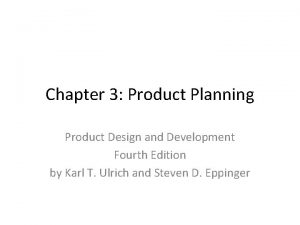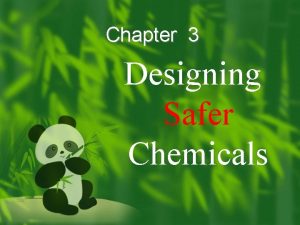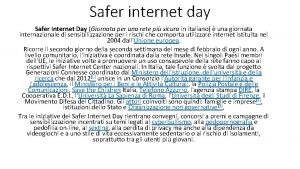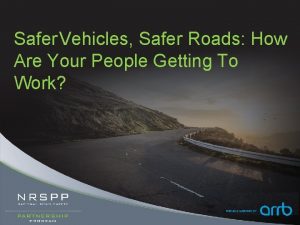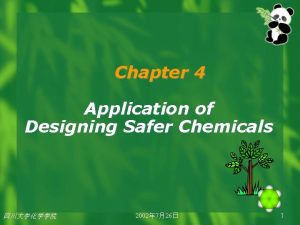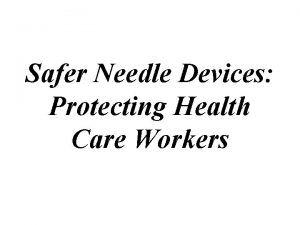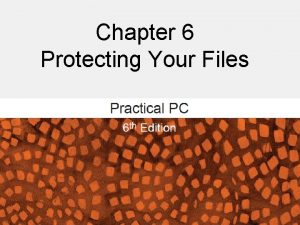Chapter 23 Designing a Safer Home Protecting the













































- Slides: 45

Chapter 23: Designing a Safer Home – Protecting the Environment from our Homes

What I Will Learn • To understand the importance of proper waste management • To distinguish between organic and inorganic waste • To identify the causes and effects of air, water and noise pollution • To investigate ways that the consumer can protect the environment

Protecting the Environment from Our Homes • A hygienic home has a major impact on our general health and wellbeing, making it a pleasant and safe place to be. • Where bacteria are allowed to thrive in damp and dirty conditions, the risk of infection and disease is higher. • The kitchen and bathroom are two areas that require a high standard of hygiene. • Good standards of personal hygiene are also required. • In order to prevent waste of our natural resources and protect our environment, we must become aware of how our behaviour in our homes can affect the world outside.

Household Waste • Each year we throw away millions of tonnes of household waste, which is disposed of by local authorities or private companies. • How we deal with disposal of waste is very important.

Household Waste (continued) Waste produced in the home falls into two categories: Organic waste Is biodegradable which means it breaks down naturally over time and does no harm to the environment, e. g. sewage, paper and food waste. Inorganic waste Is not biodegradable – it does break down but can be recycled, e. g. glass, plastic and metal.

Household Waste (continued) • Local authorities also ensure that sewage is disposed of hygienically. • Private companies run bin collection services. • A lot of waste is sent to be disposed of in landfill, which is the least favoured option in the EU waste hierarchy. • New pricing systems for bins were implemented in July 2017 to encourage proper waste disposal, e. g. charging by weight for refuse should encourage people to recycle and compost.


Quick Revision 1. Explain the difference between organic and inorganic waste. 2. What does the term biodegradable mean? 3. Indicate whether the following are examples of organic or inorganic waste: potato peelings banana skins paper glass bottles tin cans flowers egg shells Organic waste Inorganic waste

Waste Disposal Activity Fill each bin with at least ten items from the list below. Paper Kitchen food scraps Fruits and vegetables General refuse Newspapers and magazines Out-of-date food Aluminium foil Plastic bags Nappies Cooked and raw foods Cardboard Plastic food wrappings Plasters Animal waste Old catalogues Netting from fruit Eggs and dairy Tin cans Meat, fish and bones Tea leaves and coffee grounds Ashes Drinks cans Vacuum cleaner bag/contents Plant trimmings Cut flowers Plastic bottles Bread Cake and biscuits Plastic food containers Grass clippings Milk cartons Contaminated plastics Clear, clean plastic film Candles Pasta and rice Paper napkins Broken delph Green bin Black Bin Brown Bin

Composting Roughly one-third of your household wheelie bin is made up of organic kitchen and garden waste, which is easily biodegradable. Organic waste materials are divided into greens and browns. • Green organic waste is usually wet or moist, is often green in colour and has a high nitrogen content, which activates the decomposition process. • Brown organic waste is very often brown in colour, is generally dry and has a high carbon content. In contrast to its green counterpart, this type is slower to break down.

Composting Experiment: Making a Compost Bottle Equipment needed: Work in pairs to • A two-litre plastic bottle do this interesting experiment • Sharp scissors • Newspaper, ripped into small pieces • Some fresh compost or packet of ‘compost maker’ or ‘accelerator’ from a garden centre for quick compost! • Materials for different layers: soil, leaves and dry grass, fresh fruit and vegetable peelings, used coffee grounds and teabags • Water spray bottle • Sticky tape See Activity 23. 10 in the TRB

Composting Experiment: Making a Compost Bottle What to do: 1. Cut off the water bottle top, but not completely − leave a small section to act as a hinge. 2. Place 2− 3 cm of soil in the bottom of the bottle. Spray with water. 3. Then add 2− 3 cm of vegetable peelings. Make sure they are cut up quite small. 4. Cover with a thin layer of soil and compost. 5. Add another layer of vegetables and cover with soil. 6. Add a layer of shredded newspaper and cover with soil.

Composting Experiment: Making a Compost Bottle 7. 8. Repeat layers until the bottle is nearly up to the cut. The final layer should be soil sprinkled with ‘compost maker’ or ‘compost accelerator’. 9. Spray with water. 10. Close the bottle and seal with tape. 11. Put it in a sunny place and watch what happens over time. It will take several months for the material to break down into compost, so don’t worry if it looks like nothing is happening − it will! Then you can remove the top of the bottle, plant some seeds and watch them grow.

The EU Waste Hierarchy

Prevention is the most favoured option. • Avoid buying or using products that are not environmentally friendly. • Buy only what you need, and preferably products that can be reused, e. g. rechargeable batteries and ink cartridges. • Maintain and repair goods rather than replacing them. • Avoid overpackaged products, use refills, and do not buy pre-packed fresh fruit and vegetables. • Buy an all-purpose household cleaner, instead of different ones for each cleaning job.

Preparing for Re-use • Walk or cycle to work/school if possible or car pool instead of driving. • Some materials like plastic, cardboard and glass can be reused, e. g. glass jars for preservation. • Sell or give away unwanted items to charities. You could even sell your possessions in a car boot sale and earn some extra cash. • Choose re-usable shopping bags over disposable ones. • Collect water run-off from the roof in a bin or bucket to water the garden with.

Recycling • A lot of household waste can be recycled into useful products, so conserve resources. • Compost kitchen waste to make garden fertiliser. • Purchase goods made from recycled products. Waste Challenge Choose some items from the recycling bin and recycle/upcycle them for another use

Energy Recovery Energy can be recovered, e. g. by using gases emitted from landfill sites to produce heat. Landfill gas collection from capped landfill area

Disposal This is the least favoured option as it is the most wasteful of resources and causes disposal problems.

WEEE Directive (Waste Electrical and Electronic Equipment) • Under this EU directive, producers must organise for the collection and treatment of waste electrical and electronic equipment. This includes anything with a plug or battery, • Large and small appliances can be recycled for free.

Advantages of Recycling • Lowers waste disposal costs and the amount of waste going to landfill • Creates jobs • Reduces litter and pollution problems • Reduces our use of raw materials, like trees and metals • Saves energy

Recycling Symbols • Recycling symbol: Used by manufacturers to indicate that goods and packaging are recyclable. • The Green Dot indicates that the suppliers of the packaging bearing the green dot have contributed financially to the cost of recycling. • In Ireland, the green dot symbol is only used by members of Repak.

Recycling Symbols (continued) • Recognised across Europe and worldwide, the EU Ecolabel helps identify products and services that have a reduced environmental impact throughout their life cycles.

Pollution is any harmful addition to the environment. • We all contribute to the pollution of our environment. • We use up resources like water and fuels, produce waste like carbon dioxide and sewage, and pollute the air and water with smoke, fumes and litter. • If everyone made an effort to reduce pollution, the whole planet would benefit in the long term. • There are different types of pollution, including water, air and noise.

Water Pollution

Water Pollution: Causes • Toxic factory waste including chemicals • Farm waste, e. g. leeching or seepage of fertilisers, insecticides and slurry • Domestic waste, e. g. seepage from sewage and waste water • Oil spills and illegally dumped rubbish • Vegetation, dirt and bacteria from the natural environment

Water Pollution: Effects • Causes algal bloom, which uses up oxygen in water and destroys aquatic life • Looks and smells horrible • Kills fish and marine life • Harms our tourist and fishing industry • Leaves water unsafe to drink

Water Pollution: Steps Towards Change We need to: • Use green/organic cleaning products and detergents • Safely dispose of all household chemicals • Limit our use of artificial fertilisers and pesticides • Be more aware of how we dispose of waste and do not litter The government need to: • Monitor factory and farm waste • Construct more efficient sewage treatment systems • Enforce heavy penalties for illegal disposal

Air Pollution

Air Pollution: Causes • Smoke from industrial and domestic burning of fossil fuels produces gases like nitrogen, carbon dioxide and sulphur dioxide • Carbon monoxide from exhausts of cars • Sulphur dioxide from traffic and incomplete burning of fuel • CFCs (chlorofluorocarbons) used in old fridges and aerosols • Overuse of chemical sprays and cleaning agents

Air Pollution: Effects • Global warming affects the earth’s climate • Ozone layer is damaged, which leads to skin cancer and eye damage • Increase in allergies and respiratory conditions like asthma and bronchitis • Acid rain lowers p. H of soil, damaging plants and wildlife; it also damages metals and stone

Key Term: Acid Rain • Acid rain is the term to describe polluted rainfall. The moisture in the atmosphere mixes with gases like sulphur dioxide and carbon dioxide, forming a weak acid. • Acid rain affects the plant and animal life of rivers and lakes by reducing the numbers of some species.

Air Pollution: Steps Towards Change • Use renewable energy resources • Avoid products with CFCs, choose pump-action and ozonefriendly products • Use smokeless fuels and unleaded petrol • Use cars less – car pool, use public transport, or walk or cycle more • Buy energy-efficient appliances • Use green/organic cleaning products and detergents

Noise Pollution

Noise Pollution: Causes • Aircraft, rail and road traffic • Loud music, TV, radio • Industrial noise – factories, construction work and lawnmowers • Burglar and car alarms, dogs barking • Nightclubs, pubs and discos • Electrical appliances – food mixers, washing machines and lawnmowers

Noise Pollution: Effects • • Can make selling properties difficult Gives a poor image of an area Upset residents and tension Headaches, irritation and insomnia

Noise Pollution: Steps Towards Change • Choose vehicles with lower noise emissions, e. g. hybrid or electric cars • Have consideration for neighbours • Insulate your home well • Choose housing away from transport systems and bars/nightclubs

The Ozone Layer Ozone (O₃) is a form of oxygen located 20– 30 km above the earth’s surface. It protects the earth by absorbing the sun’s harmful ultraviolet rays. When the ozone layer is damaged, ultraviolet radiation can reach the earth and have harmful effects, including: • Increase in skin cancer • Increase in eye cataracts • Damage to plant and animal life

The Ozone Layer The ozone is destroyed by: • Chlorofluorocarbons (CFCs) found in aerosols, old refrigerators, air conditioning systems, foams used in furniture packaging and insulation • Halons found in fire extinguishers

Did You Know? • A hole in the ozone layer has already developed over Antarctica. Bans on the use of CFCs in aerosols and refrigerators in most countries have halted this depletion and the ozone layer is already showing signs of recovery. • Greenhouse gases including carbon dioxide and ozone help to keep the earth warm. However, if too many greenhouse gases, such as CFCs, build up in the atmosphere, too much heat is trapped, causing global warming. Rising sea levels and damaging climate change, such as storms and flooding, are the result.

How You Can Make a Difference • Use ozone-friendly pump-action sprays and products • Use non-aerosol alternatives, e. g. roll-on deodorants • Dispose of old fridges in an environmentally safe way through the WEEE scheme

Discovery Learning It is important to be environmentally aware, to help to protect our planet and preserve it for future generations. There a lot of Irish and international organisations that have relevant and up-to-date information on environmental issues. Visit their websites, and share any interesting information with the class.

Green Schools • Many Irish schools participate in the Green-Schools environmental management and award programme. • Schools taking part work through eight themes: 1. Litter and Waste Energy 5. Global Citizenship – Litter 2. Water 6. and Waste 3. Travel 7. Global Citizenship – Energy 4. Biodiversity 8. Global Citizenship – Marine Environment • An internationally recognised award, the Green Flag is awarded to the school when each theme is completed.

Green Schools (continued) • This programme reduces waste, litter, energy and water consumption, and promotes sustainable and active travel to and from school. • It develops the decision-making skills of the students and builds their confidence. • It gives students a sense of pride in their improved school environment.

Quick Revision 1. Explain why it is important to manage household waste appropriately. 2. Distinguish between organic and inorganic waste. 3. Identify the causes and effects of air, water and noise pollution. 4. Discuss ways in which consumers can protect the environment.
 Chapter 9 obtaining and protecting your credit
Chapter 9 obtaining and protecting your credit Chapter 20 civil liberties protecting individual rights
Chapter 20 civil liberties protecting individual rights Chapter 9 obtaining and protecting your credit
Chapter 9 obtaining and protecting your credit Chapter 20 civil liberties protecting individual rights
Chapter 20 civil liberties protecting individual rights Chapter 20 civil liberties protecting individual rights
Chapter 20 civil liberties protecting individual rights What is noninstallment credit
What is noninstallment credit Reactions of aldehydes and ketones summary
Reactions of aldehydes and ketones summary Aldehyde + ag2o
Aldehyde + ag2o Carbamate protecting group
Carbamate protecting group Important john proctor quotes
Important john proctor quotes Protecting student data
Protecting student data Protecting consumers savers and investors examples
Protecting consumers savers and investors examples Single species approaches to protecting biodiversity
Single species approaches to protecting biodiversity Single species approaches to protecting biodiversity
Single species approaches to protecting biodiversity Apa arti home care
Apa arti home care Perbedaan home care dan home visit
Perbedaan home care dan home visit New mobile home sales oak springs mobile home community
New mobile home sales oak springs mobile home community Plural of flower
Plural of flower Come home come home jesus is calling
Come home come home jesus is calling New mobile home sales oak springs mobile home community
New mobile home sales oak springs mobile home community Let's go to your house
Let's go to your house John heartfield
John heartfield She said that, home economics stands for the ideal home.
She said that, home economics stands for the ideal home. Home sweet home survive
Home sweet home survive Safer
Safer 8 elements of safer access
8 elements of safer access Act 2 scene 1 othello
Act 2 scene 1 othello Engineering a safer world
Engineering a safer world Safer recruitment consortium
Safer recruitment consortium Conflict management seminar
Conflict management seminar Why are expressways safer than other types of roads
Why are expressways safer than other types of roads Www safersys org
Www safersys org Safer sign out
Safer sign out Safer sign out
Safer sign out Single level inheritance is safer than
Single level inheritance is safer than Engineering a safer world
Engineering a safer world Safer-r
Safer-r To err is human: building a safer health system
To err is human: building a safer health system Www.safersys.org
Www.safersys.org Safer web mc
Safer web mc Dvsat questions
Dvsat questions Safer care victoria
Safer care victoria Self-driving coalition for safer streets
Self-driving coalition for safer streets Safer places scheme
Safer places scheme What are three possible exiting problems
What are three possible exiting problems Product design planning
Product design planning
